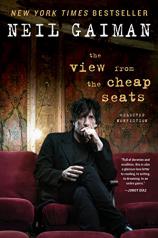Reading Group Guide
Discussion Questions
The View from the Cheap Seats: Selected Nonfiction

1. The title of this collection of nonfiction, THE VIEW FROM THE CHEAP SEATS, is also the name of an article recalling Neil Gaiman’s experience at the 2010 Oscars. Why does it work as a title for this book? What is the “view” Gaiman shares, and how do you understand “the cheap seats” in regards to the essays, speeches and articles here?
2. The collection is divided into 10 sections by subject matter. Which subjects were you most interested in and why? Where was the topical overlap? Are there any overarching themes or ideas that connect everything collected here?
3. In the introduction, Gaiman writes that he hopes his love of certain authors “will be contagious,” and that is why he included essays or book introductions about them. Were you already familiar with any of the authors he wanted to introduce you to? If so, did you gain new perspective on them? Which authors were new to you, and are you now interested in reading what they wrote?
4. Also in the introduction, Gaiman asserts that readers are not obligated to read the work collected in THE VIEW FROM THE CHEAP SEATS in any particular order. Did you read the book start to finish, or did you jump around? If you jumped around, how did you decide what to read next?
5. In a book of short essays, readers often do not enjoy each of the pieces with the same level of enthusiasm. For you, which did you enjoy the most? Were there any that did not strike a chord with you?
6. Throughout the book, Gaiman reveals much about himself and his life. He mentions his wife and children, and especially his own youth as an avid reader of genre fiction. How did these glimpses of the author inform your reading of the book? Does the book feel particularly personal? Did you create an image in your mind of the young Neil Gaiman, book in hand?
7. Discuss Gaiman’s ideas about myth and fairy tales (see “Reflections on Myth [With Digressions into Gardening, Comics and Fairy Tales]”).
8. Discuss Gaiman’s ideas about children’s literature as explained in “What the [Very Bad Swearword] Is a Children’s Book Anyway? The Zena Sutherland Lecture” and others. How do you think his beliefs about children’s books and his style of writing as a children’s author were influenced by his own habits as a young reader?
9. Gaiman writes a lot about genre fiction, especially fantasy, science fiction and horror, as well as comics. Are you a reader of these genres? How do your thoughts on genre fiction line up with Gaiman’s? What new perspectives did you gain while reading this book?
10. “A Wilderness of Mirrors” is not explicitly about writing but instead is about visual images and identity. In what ways does it address the essential questions “Who am I?” and “Who are we?” How can pictures or portraits of others inform us about ourselves?
11. Think about the idea that all books have genders. Is this something you have thought about before? Does STARDUST feel feminine or like “a girl’s book’? Does AMERICAN GODSseem male or masculine? Can you detect or determine the gender of your favorite books? If books have genders, what about songs or albums or works of visual art? Does thinking about gender in relation to works of creative expression challenge you to consider them in new and useful ways?
12. If you could choose just one selection from THE VIEW FROM THE CHEAP SEATS to share with a friend, which one would it be and why?
13. Discuss how Gaiman’s work as one type of writer, a journalist, influenced his work as another type of writer, one of fiction. Why did he leave journalism, and what did he take from it when he left?
14. In the short piece called "How Dare You: On America, and Writing About It," Gaiman talks about being an English writer who has set his work in America and the criticism he dreaded for doing so. Discuss his assertion that he "created an America that was entirely imaginary,” in which SANDMAN could take place and his desire to "write about America as a mythic place." How does culture of origin affect writing about another culture? What if the two cultures are closely related and historically tied? What does it mean to write about some place that actually exists as mythic or imaginary?
15. Many of these selections are about inspiration, found in the work of other writers, in music and in friendship. What are the types of characteristics or qualities that seem to inspire Gaiman? Are you inspired by the same sort of qualities?
The View from the Cheap Seats: Selected Nonfiction
- Publication Date: May 16, 2017
- Genres: Essays, Nonfiction
- Paperback: 544 pages
- Publisher: William Morrow Paperbacks
- ISBN-10: 0062262270
- ISBN-13: 9780062262271








